Shaping Vancouver 2019: Conversation 2
What's the use of heritage?: What do we do about neighbourhoods?Oct. 9, 2019
In this session, we looked at how neighbourhoods and neighbourhood character are part of the heritage discussion in Vancouver and how they function in the context of the City-Wide Plan.
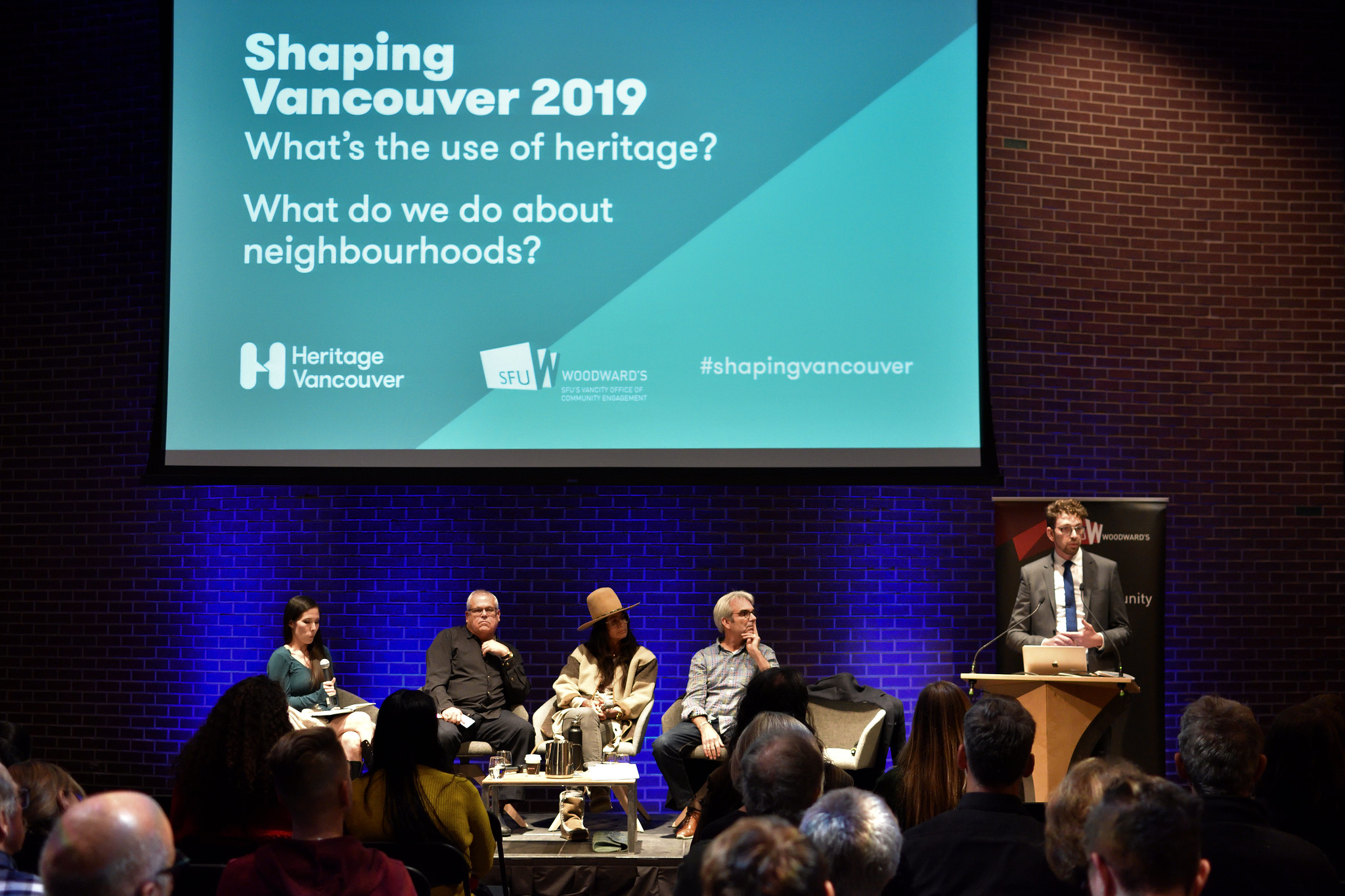
Moderator
Bill Yuen:
- Executive Director of the Heritage Vancouver Society
Panelists
Richard Evans – Chair of RePlan, a committee of the False Creek South Neighbourhood Association.
Scot Hein – adjunct professor in the Master of Urban Design program at UBC, previously the senior urban designer with the City of Vancouver.
Jada-Gabrielle Pape – facilitator and consultant with Courage Consulting.
Jennifer Maiko Bradshaw – Renter, pro-housing activist and Director of Abundant Housing Vancouver.
In the second installment of Shaping Vancouver, we looked at the role of neighbourhoods and neighbourhood character in maintaining the diversity of the city and unique communities.
Neighbourhoods are often positively associated with community. They tend to have a combination of qualities that communities identify with which can make them distinct. These include the people, the types of interactions they have with each other, nature, types of commercial spaces, housing tenure, and public spaces in addition to the type and design of buildings. However, there are conflicting views as to whether this distinctiveness is positive or not.
Particularly with regard to residential neighbourhoods, some argue that “neighbourhood character” must be maintained to preserve the diversity of the city. Others note however that “neighbourhood character” frequently serves as an instrument of exclusion, making people feel unwelcome and marginalizing them.
Neighbourhoods that do not evolve risk stagnation; while neighbourhoods that change too rapidly erase the attributes that make them unique.
Are there then qualities of neighbourhoods that should be cultivated or protected? As Vancouver faces a housing crisis, how do we go about discussing neighbourhood change?In our second talk in this year’s series on “What’s the use of Heritage?”, we take a city-wide view of neighbourhoods as the city embarks on a City-wide Plan.
Panelists
Richard Evans – Richard has lived in False Creek since 1986. He is an architect who practices within his own firm, and has a broad range of experience with primarily First Nation communities across BC. Richard has chaired *RePlan from its’ inception, and is an active member of the False Creek Housing Co-operative. Richard was instrumental in creating *RePlan, and recognized early in the process that approaching the City of Vancouver to address the renewal of leases as a collective of tenure interests rather than as individual lease holders would lead to a more comprehensive and satisfactory outcome. In addition to chairing the regular activities of *RePlan, Richard is active on the organization’s Leadership Group, and liaises with the City of Vancouver on a regular basis to explore options for the renewel of a neighbourhood that is recognized world wide as an example of successful urban design.
Scot Hein – Scot Hein is an urban design consultant and was the University of British Columbia’s Urban Designer until May 2018. He is an Adjunct Professor of Urban Design in UBC’s Masters of Urban Design Program launched in 2014. Prior to this work he was the Senior Urban Designer for the City of Vancouver and led the city’s high profile Urban Design Studio for 10 years of his 20 year career.
Jada-Gabrielle Pape – Jada-Gabrielle Pape is Coast Salish from the Saanich and Snuneymuxw Nations. She has been working with urban and rural First Nations people and communities since 1992. As a facilitator and specialist in cultural safety training and workshops Jada has worked with doctors, nurses, doulas, prison staff, prison inmates, women in the sex trade, teachers, Chiefs and Council, government agencies, non-profits, elementary and high school students. Her professional experience includes UBC’s Museum of Anthropology, BC Centre for Disease Control, the Vancouver School Board and BC Women’s and Children’s Hospital. Her work has brought her to First Nations communities across the province. Jada is a certified professional counsellor, a mixed media artist, a single mother to a fantastic fifteen year old and a proud East Van community member. Much of the knowledge that Jada draws upon is respectfully carried forward from the generous traditional teachings of Elders, Community members, and valued mentors.
Jennifer Maiko Bradshaw – Data analyst, renter, and pro-housing activist with Abundant Housing Vancouver. Jennifer has fought for social justice for many years on issues ranging from freshwater accessibility in developing countries to ensuring the human rights of LGBTQ+ people. She strongly believes in applying an intersectional lens to housing and preservation in the context of historically inequitable use of unceded land and currently accelerating inequality of land wealth.
Moderated panel discussion
How do you feel the term neighbourhood character is used? (3:23)
Jennifer opened the discussion by talking about historic inequalities in heritage and city planning in Vancouver, with First Shaughnessy as a prime example. Jennifer showed a video where Shaughnessy was being used with the word “heritage” and connected it to her lived experience of the unfair and unequal ways in which the term “neighbourhood character” is being used. She stated that the term is being used to protect areas like Shaughnessy, which is where heritage is being used to protect old houses and prevent accessibility and equality in Vancouver’s neighbourhoods. Jennifer advocated for a “power analysis” to see how some areas, like Shaughnessy, are “adjacent to power with wealthy landowners benefitting from systems that enhance and preserve their power.” A stark contrast is seen with the development at East 1st and Clark, which includes a safe injection site. She closed her statement by saying how “inclusivity, sustainability, and affordability are all things we should be mindful of when talking about heritage.”
Scot followed up by saying how he is an advocate for neighbourhoods and wants to capitalize on the unique aspects of Vancouver’s 122 micro-local neighbourhoods and use each area’s historical and cultural roles as part of dialogue on affordability. In particular, he pointed out single-family neighbourhoods as a promising way to address the city’s affordability crisis. Scot also said that he hopes that “under the auspices of the city-wide plan there’s a cultural landscape study or statement of significance…that recognizes the Indigenous role and contribution” that go beyond just writing or holding interpretive programs. He stated that he did not equate ‘character’ too much with ‘aesthetic’, but more with ‘experience’ and the experience of streets and neighbourhoods.
Jada also talked about her lived experience and emphasized the city’s Indigenous history and how neighbourhoods are an inherently foreign idea due to their European roots. Moving forward from the “colonial violence” which erased Indigenous histories, names, and narratives for the region, Jada hopes to shift the discussion of “what a community is in that we have to consider they’re modern constructs.” Ideas of inclusion have to be completely fresh. “There’s a lot of white faces in this room, which means there’s a lot of born privilege, and with that privilege can be wonderful advocacy and wonderful ally-ship.”
Finally, Richard talked about how “where we live cannot just be constructs and has to grow out of something”; there has to be genuine growth and development to support life. He acknowledged Jada and Jennifer’s discussion of the foundational issues in what neighbourhoods mean and said that the conversation has to be close to what Scot discussed in that it has to include “the experience of neighbourhoods and what makes them worth living in.” He also expressed the need to talk more about co-ops and different kinds of neighbourhoods and the physical environment supporting neighbourhood character and growth.
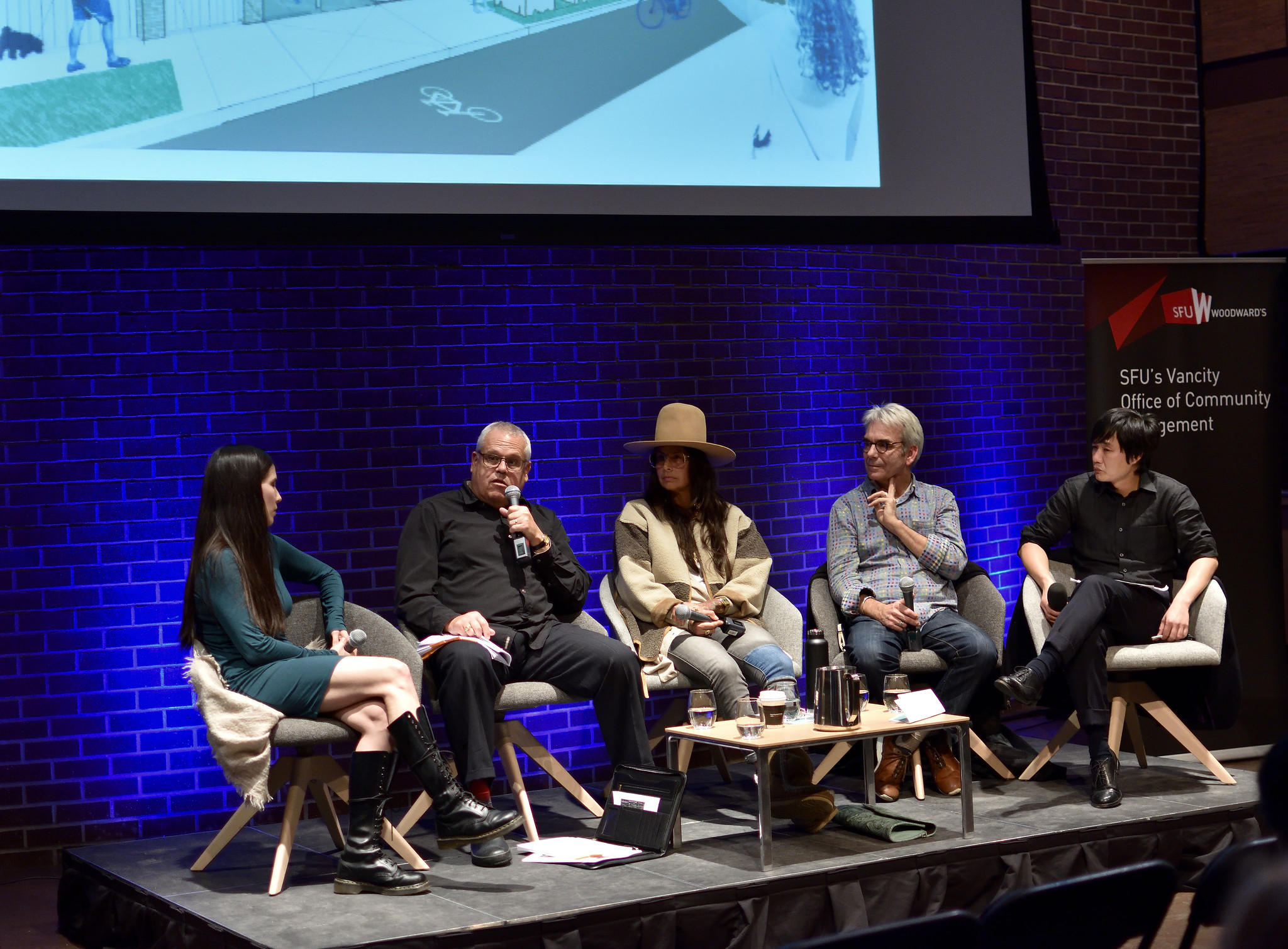
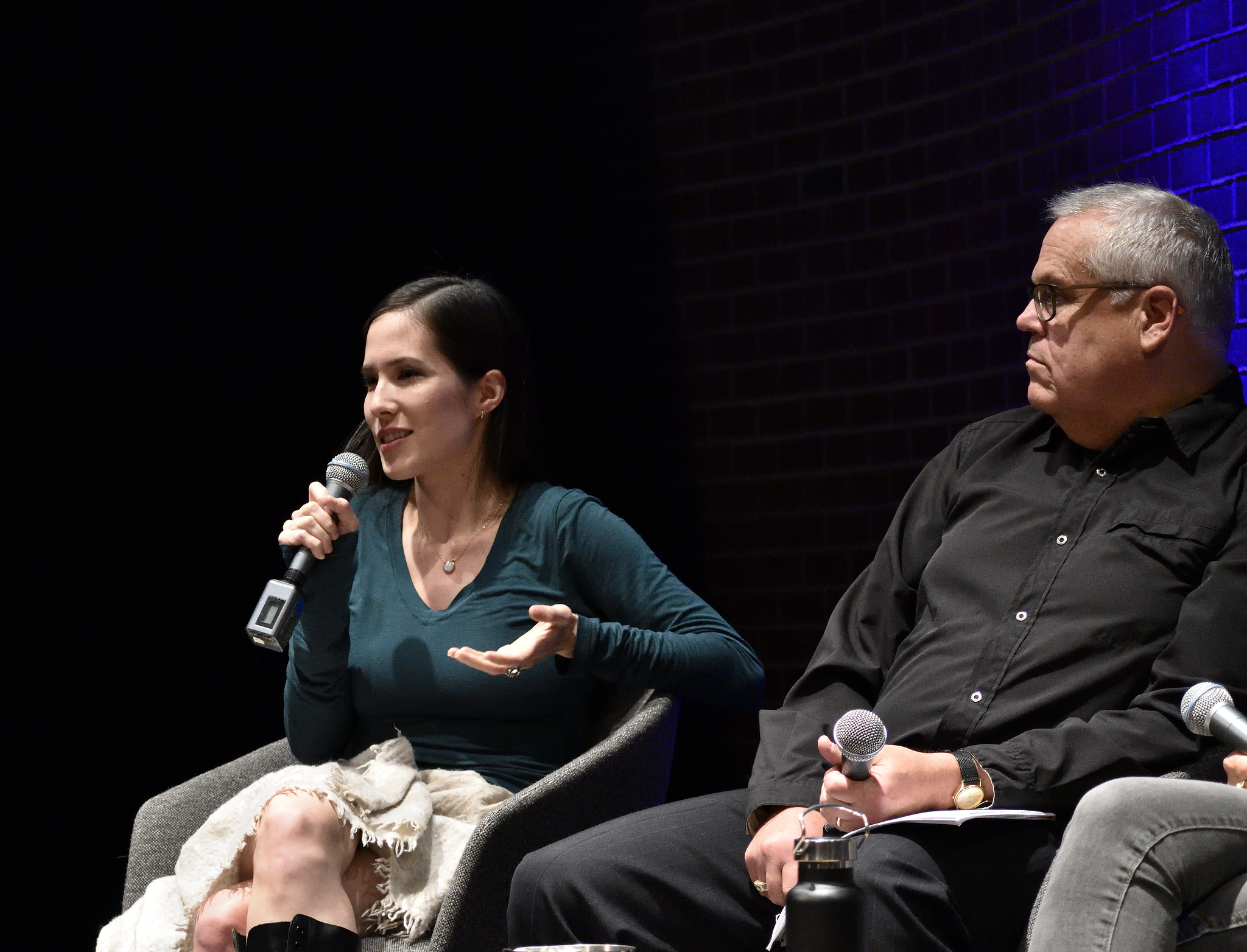
How do we change the conversation on neighbourhoods? (19:59)
Jada discussed how changing the conversation on neighbourhoods requires us to engage closely with those who live in the neighbourhoods, as “designers have a different set of skills from those who live in neighbourhoods.” She emphasized the problems of neighbourhood consultation, from the lack of conversation to accessibility barriers such as language. “What I am seeing now is that the city is a massive machine full of an enormous amount of people, and it’s quite a broken machine full of very caring, very intelligent, very deeply creative and committed people who are trying very hard to change the machine that is broken. So it’s actually quite hopeful, and I feel like if we can find a way to have collective conversations that are driving these processes rather than have external plans come in and put on to communities, I think it’s a beginning place.”
Jennifer emphasized how it may be the politics that are broken instead of the machine. She talked about problems of representation in city hall and how it is “white, wealthy landowners who come out to speak, overwhelmingly against social housing.” These people consistently show up and say ‘no’ to housing developments, and Jennifer concluded by calling for better public education as a way to overcome the barriers present in consultation.
Scot took a historical view and looked back towards the evolution of single-family housing policy in the 1940’s to post-Expo ’86 policy which accelerated the current paradigm “which is essentially about land assembly to bigger sites which then compels larger deep underground parkades at $70-$80 000 a stall.” Scot advocated for a top-down look on how the city machinery is broken and to look for an alternative companion paradigm to work within the current city planning structure.
Finally, Richard shared his optimism on changing the city’s power structures. He talked about how his work in False Creek South trying a different process to determine significance in partnership with First Nations. He described this “as a way to frame a conversation early enough before the planners come along and start to talk about solutions that didn’t have that conversation.”
Richard, your neighbourhood doesn’t seem to be fighting projects as much as welcoming them. Can you tell us some more about some of the things you’re taking on? (27:30)
Richard talked about the origins of False Creek South and how it shifts the conversation of neighbourhoods. Instead of being about “property owners talking about their self-interests,” he talked about neighbourhoods as a “collective enterprise as opposed to an individual interest within it.” He likes the neighbourhood association model as long as we are “very careful with the kinds of venues we create for the conversations that we’re having”; in the context of False Creek South, it was the issue of modular housing that the neighbourhood could hold productive conversations around.
Jennifer brought up the examples of the Grandview-Woodland Area Council (GWAC) who opposed the East 1st and Clark development, and the Shaughnessy Homeowner’s Association as negative examples of neighbourhood associations. She acknowledged that the Shaughnessy’s Homeowner’s Association is structured differently from Richard’s as it exists to “maintain their crème de la crème” of Shaughnessy. She asked us to consider who that model of neighbourhood associations is excluding.
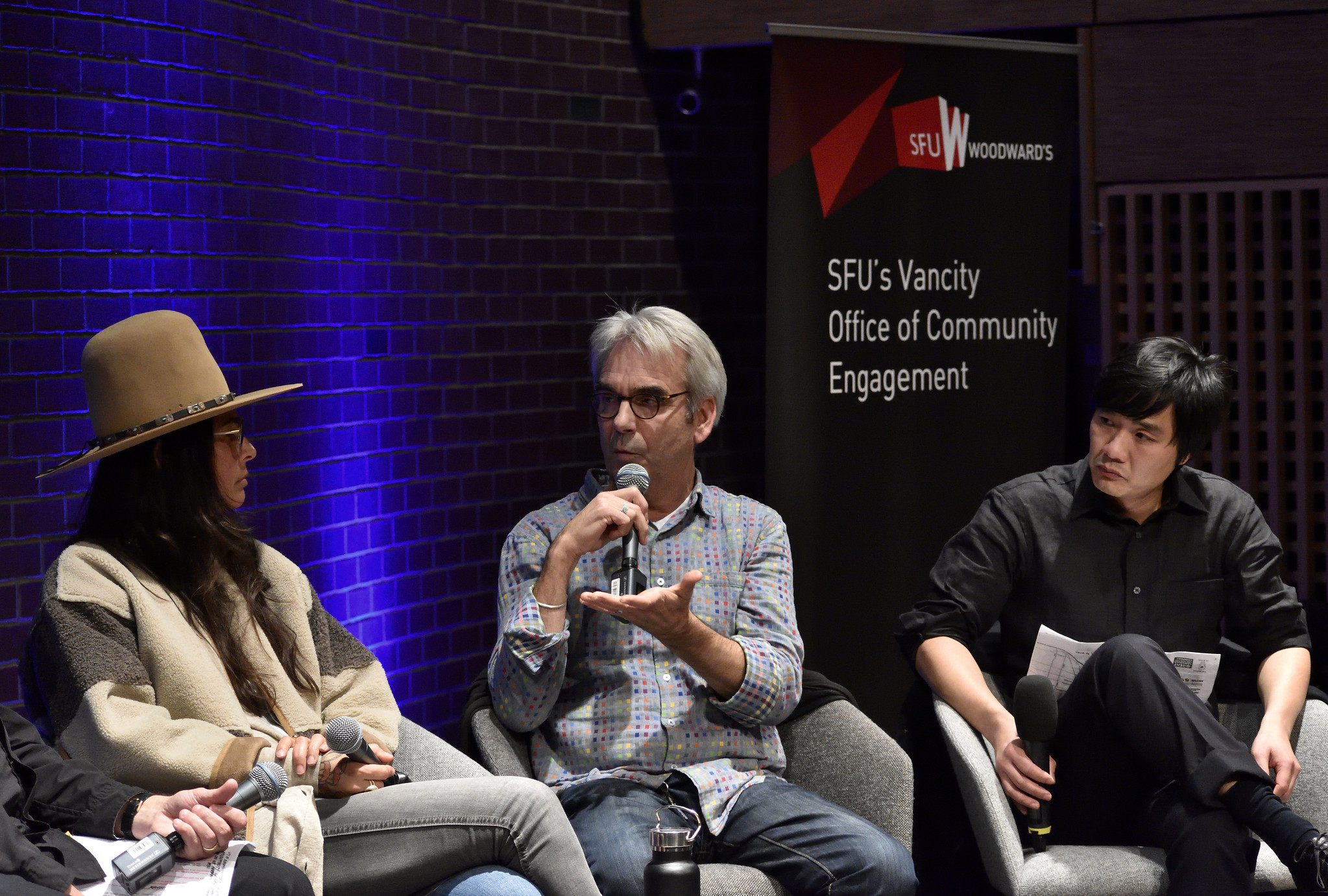
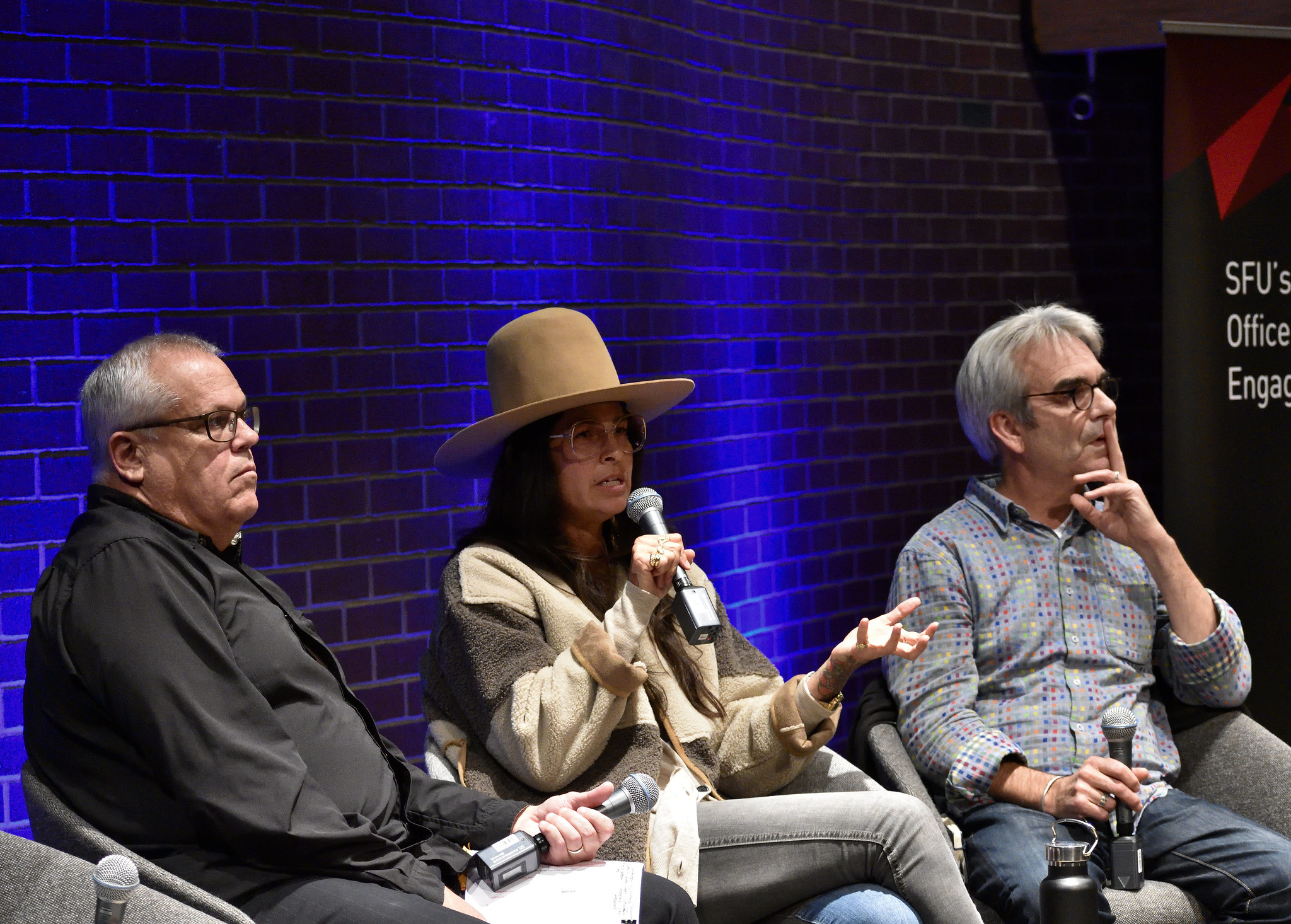
Do you truly believe that these neighbourhoods are only self interested and are rebelling against the idea of housing for those who need it? And if you truly believe that’s happening, then is there a way to have these conversations to change how people think? (31:58)
Jennifer talked about temporary modular housing – despite being good for the community and having positive feedback – is being opposed by community organizations to “maintain their exclusive neighbourhoods”. West Point Grey was brought up as an example of this process.
Jada emphasized a conversation which focuses on what everyone has in common because we “fundamentally want very deeply the same things”: the need for “safety, shelter, supportive environments”. Instead of engaging in the “I’m right game”, we need to enter conversations with genuine curiosity and push through when the conversations become uncomfortable – “check in with our own discomfort”. What we read as combative can become respectful and productive. She encourages people to “wonder if there’s a way we can have some healthy discourse or some productive discourse” in cases where people do not agree.
Scot is optimistic about this progress as he thinks we also need to meet “head-on the existential, local immediate crisis of affordability while strengthening the character, which is to say the experience, of our single-family neighbourhoods”. To him, that will need two things: continued discourse and better choices. Jennifer responded by cautioning the audience that these are just options – genuine consultation is what’s missing.
Richard chimed in saying that the angry white men that Jennifer talks about are looking at a model where they see conversations as transactional, where there’s an idea that “you’re taking something away from me, as opposed to augmenting and supplementing and improving something that I have”. Jennifer said that those models are what they set up for themselves and made it exclusionary for other people.
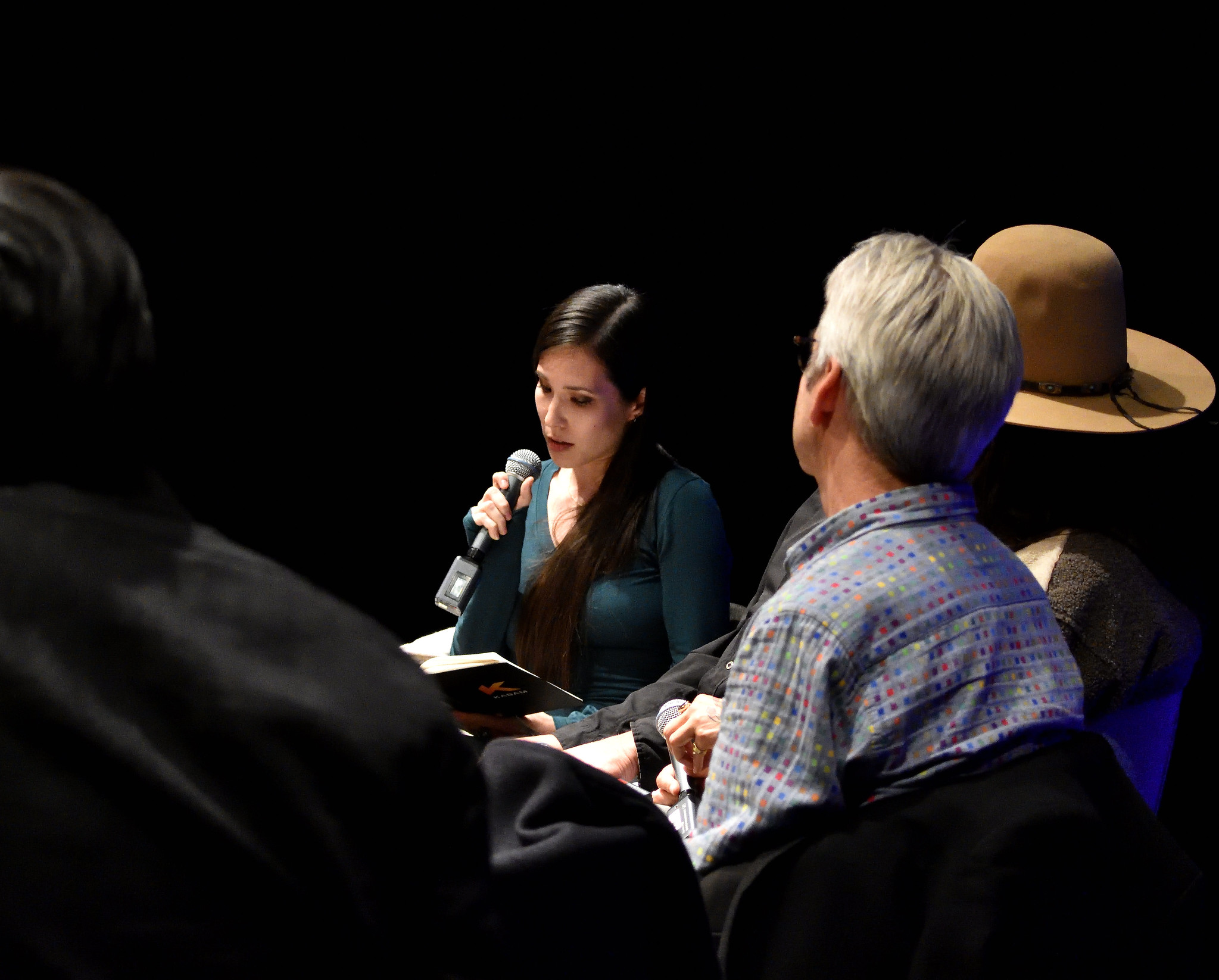
Do you feel that’s changing? The Arts and Culture Plan mentions heritage and intangible heritage. When I see that report, I see a call for representation and an indictment of exclusive models of heritage. (48:19)
Scot brought up the idea that there is room for a new paradigm of single-family neighbourhoods through “smaller, incremental land ownership and in a way that you can have lower cost rental opportunity”. This is a way to build conversation that isn’t about aesthetic or superficial regulation but “visual interest, vibrancy, complexity, all those things”.
Jada expressed cautious hope about Indigenous qualities and narratives being applied across the city but said that she doesn’t feel like “we are in a climate where people are ready to listen very deeply to Indigenous peoples’ stories and to listen openly and to integrate it”. She reiterated the need for deep conversations and for people to be comfortable with the truth – which is “seen as threatening and seen as dangerous and is adversarial” – before true reconciliation can start.
Jennifer brought up ideas about how to integrate with Indigenous communities and ways to communicate with them. A key example was Senakw. She said how important Indigenous voices are: “don’t question them, listen and learn from them.” She also expressed that we should be supporting First Nations and “when they get control of the land, they should be able to do what they think is best with it”.
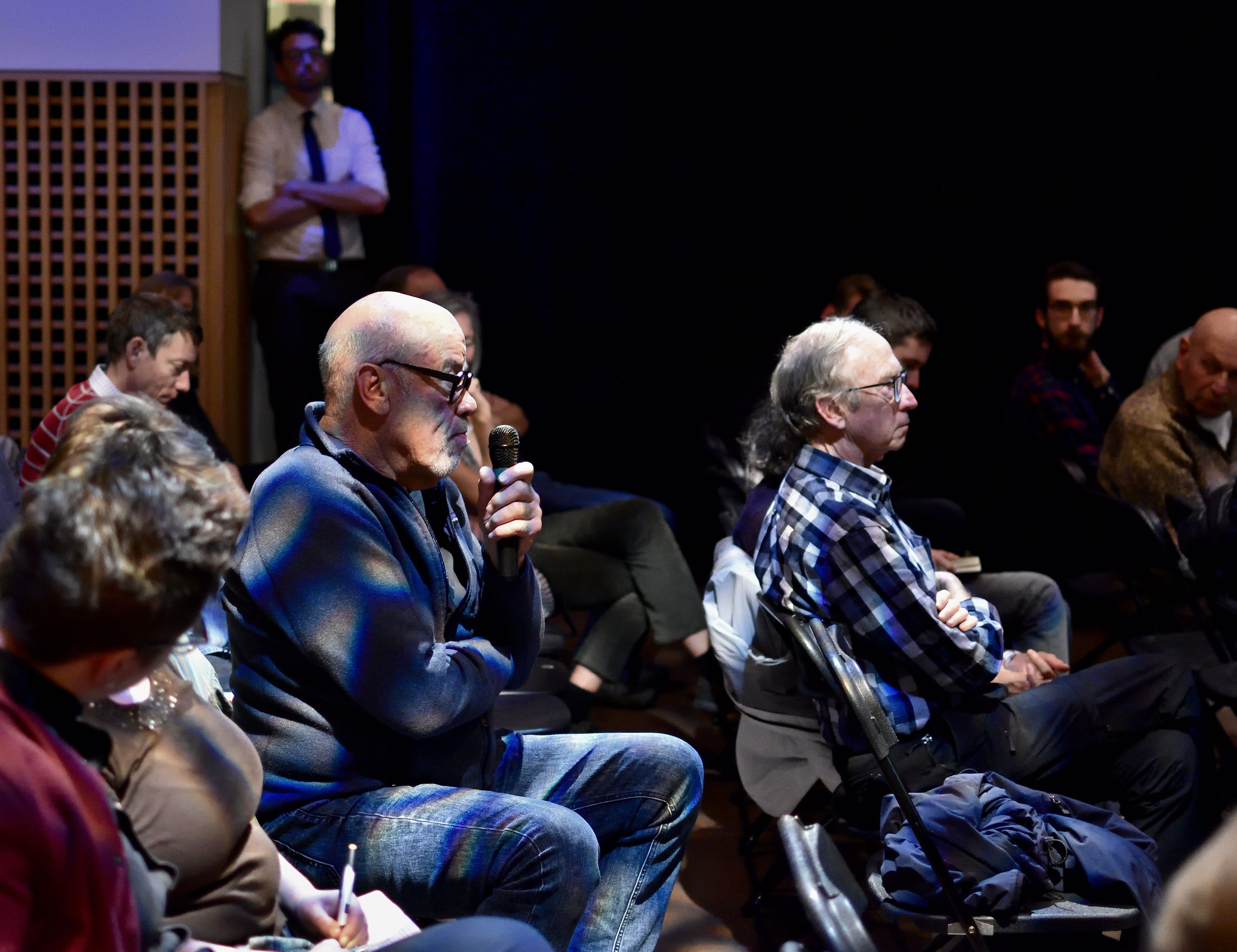

Questions from the audience
The audience member talked about how neigbourhoods are often perceived as islands which have little interaction with each other, and emphasized how that model is exclusionary in that it forces neighbourhoods to push potential newcomers onto other neighbourhoods. They applied that to housing and how one community which doesn't want housing can force other communities to accept it. They asked the panel how to get people to move past the idea of neigbourhoods being insular and the thinking that fosters. (55:12)
Scot discussed how the city-wide plan includes references to Cascadia, which are analogous to discussing neighbourhoods as part of the network of a city and a larger region. He wants to see political leadership in positioning Vancouver as part of this larger network. He wants to see the city-wide plan acknowledge the latent potential of each neighbourhood and of the city as a part of the region.
Richard said that it’s handy for his organization (RePlan*) to look at his community in the context of what the neighbourhood needs but, without that, “we are putting ourselves in competing fiefdoms”. He reflected upon the great model that has been fostered in False Creek South and how there could be some “way of conducting conversations” that operate as a link between being “home in the neighbourhood and speaking to the city at the same time”.
Jada talked about her own feelings about neighbourhood loyalty and how, for her, she finds it hard to leave her area of East Vancouver due to the intense connection she feels to local features such as parks. This is opposed to her feelings in other neighbourhoods, where she doesn’t feel as engaged or connected. She does not like the idea that neighbourhoods “are islands unto ourselves” and thinks “there is room to open those conversations” about neighbourhood integration “and not be married to one view or one terminology with the idea of neighbourhood or community.”
The second question addressed what makes a neighbourhood unique and how to introduce those ideas (about social aspects, workplaces, recreational spaces, etc.) into the discussion. The example of laundromats came up. (1:00:33)
In reference to the local aspects that make a neighbourhood unique and livable, Scot talked about a mapping project he had his urban planning students do where students created maps of distinguishable features in their communities at various radiuses from their homes. It showed the need to recognize the precious aspects of neighbourhoods which occur to locals and might not be significant to outsiders. He concluded by saying how important it is that we map neighbourhoods at a local level so that neighbourhoods can become more integrated and understanding about valuable features and aspects of neighbourhoods can be communicated outside of very local areas.
Pointing to one of Scot’s examples of a school in one of the neighbourhoods that a student mapped, Jennifer re-emphasized the need for an equity lens to make sure that schools are providing equal opportunities and to “make sure that these neighbourhoods are not exclusive to rich people.”
Jada talked about a personal interaction she had in her neighbourhood and how someone looked at a park and thought it was dirty, while Jada thought it was well-loved. She said that parks and free spaces, “even if they look a little active”, are not dirty and are “not problematic areas, they’re actually being used”.
Richard talked about the city like a patchwork quilt where “the togetherness makes a whole”. There is comfort and safety in your own community but a joy in going to another, and that’s something which should be celebrated. He supported Scot’s idea of mapping as a way to knit the fabric back together so that neighbourhoods meet at the edges but are still distinct.
The audience member asked the panelists about how much interaction there is between policy makers/city planners with non-profit housing groups or other organizations. They further asked about how widespread understanding of policy is and how these kinds of interactions or connection could address the needs of marginalized communities. (1:11:14)
Scot referred back to the sentiment that City Hall is filled with “wonderful passionate people…who care about the city” and are now poised to do good work, despite the large bureaucracy they are surrounded by.
Jennifer said that smaller non-profits have trouble learning the rules and laws around zoning since there are a lot of “underlying, hidden rules you have to learn”. This favours bigger developers with more infrastructure and knowledge. She thinks that the rules could be simplified to make it easier on non-profits.
The audience member thought that she had "wandered into the wrong meeting" and "thought the meeting was about heritage and saving old buildings"; she commented on how "we've talked about a number of other things, but not saving old buildings". Her concern arose from how "whenever I see a historic building come down, or a building that has a strong aesthetic appeal to me, I feel very sad...this is because I'm a historian of the 19th century and such buildings reflect the culture I come from". She further felt that she "should be hesitant about celebrating my culture and asking it to be preserved". She asked the panelists to comment on her statement. (1:13:15)
In response to the question, Scot talked about a project in Strathcona he recently worked on where an old garage was converted into two new units. He pointed to it as an example of how locally significant architecture, even if it is not on the heritage register, can be updated and turned into something significant in the modern day. He sees the new paradigm as a way to preserve the “character fabric that we have that dominates over the established neighbourhoods” while integrating it into the modern Vancouver urban landscape. It is a way to introduce new housing to Vancouver without having to adjust zoning or bylaws.
Richard asked what about the single-family home that is valuable and needs to be preserved into the future. He talked about a need for change and adapt; a “need to change to stay the same.” He connected to what Scot said and emphasized the aspects which retain the “essential qualities of what we cherish…and changing it in such a way or supplementing it in such a way that it retains the character of what you’re after.” His answer highlighted the need to balance the important qualities of single-family homes that need to be preserved with the inevitable and natural evolution of neighbourhoods.
Jada asked the audience member to touch down into their grief and use their feelings and response as a way to create a coherent and organized response to what they feel. “While there’s some sadness in that and some confusion in that, I also think that’s where the growth is”.
[Question from moderator] "I want to talk about this concept of the cultural landscape and whether or not we can consider this as a way of planning. So instead of focusing individually on character houses or heritage houses, we think of the character houses or the heritage houses in the landscape. And we identify things within the landscape that are important. So we identify the laundromat, certain heritage houses, certain natural features; like when we do the planning, all the things that are important to places that have stories, whether or not they're visually remarkable. And that way, we can get a better sort of discussion as to what we can keep - is that a better way to do it?" (1:18:02)
Scot sees this approach as a way to start as it “spiritually underpins decision-making in moving forward”. On the other hand he cautioned against the dangers of over planning, noting that neighbourhoods aren’t very dense; he would encourage the “setting up of a prospect for local identity to manifest in a way that you can’t necessarily predict”. Placeholding for that more natural aspect of neighbourhood developments allows for neighbourhoods to evolve. “How do you think about neighborhoods that are perhaps underpinned by by cultural kind of understanding, but still allows a forward looking idea and for the citizens to have some license to actually make changes themselves?”
Jennifer emphasized the development and change that happens in neighbourhoods, saying that building social housing or a opioid treatment centre to replace an old building “supersede aesthetics of any building”. By putting these kinds of new developments on a single detached housing lot, Jennifer believes that we can maintain character while still allowing for the growth of social housing.
Richard expressed support for Scot’s viewpoint. He said that in his own work, he is trying to change the dynamic between planner and community by finding “a way to involve participants in the decision-making process” and to “turn the dynamic back to the community” so that they can “participate in the mapping”. This process would allow for the community to invest itself into what is important and valuable in the neighbourhood, allowing people to reach an agreement on what those important aspects are.
The audience member discussed a housing project they are working on and how they received feedback that the project "did not fit neighbourhood character"; this led to a reflection about what neighbourhood character means. Growing up in Vancouver, the audience member shared how the neighbourhood character he'd seen was in Shaughnessy, where houses "were treated like baubles" and there "wasn't any connection with the lived culture" of the city. Essentially, they see neighbourhood character as "in terms of the characters that live in these neighbourhoods and not the aesthetic part of it". However, they also suggested that there is value in the physical form of the city and there should be resources dedicated to preservation. This balance leads him to think that there should be an emphasis on planning to facilitate "the lives of people who hope to live in those neighbourhoods" instead of emulating "a certain form that is meant to be emulated or repeated". He asked the panellists their personal definitions of neighbourhood character. (1:23:57)
Richard supported the audience member’s thoughts, saying that “where the housing forms don’t support life, I think that we’re divorcing ourselves from the character”. In False Creek, the planning has been devised in a way so that it is around courtyards where kids can play and neighbours can be connected visually and audibly to their kids. Character is derived from this form as the two work in combination. We have to “marry the two”. “They’re not exclusive from each other”.
Scot reiterated his definition from the beginning of the talk: “it’s about experience”.
This question was directed towards Richard, who earlier mentioned that the False Creek South lease is coming up soon. The audience member asked if there are plans on what to do with a large chunk of land and if there is any "engaging conversation with the city to maybe have more of a forward-thinking plan", especially with the current housing crisis. He also asked about the current residents' willingness to give up their own history in the area to accomodate a new plan in the future. (1:35:47)
Richard talked about needing to change to stay the same; he doesn’t “see it as a zero-sum game” and thinks there’s a way to add to the neighbourhood “in such a way that we’re meeting the wider need in terms of housing”. He said “that’s the vision we’re taking to the city as our position”. However, the conversation shifts depending on who they are talking to in the city.
The second-to-last question was framed as a comment, but with the audience member asking for a reaction from the panel. She described living in a heritage building in Mount Pleasant which got turned into a co-op, as well as her involvement in a grassroots Mount Pleasant heritage organization. She also reflected upon the cultural makeup of her neighbourhood and its extreme diversity. For her, "heritage is about affordability and diversity", a characterization which she did not see reflected during the talk. (1:38:37)
Scot discussed the Heritage Triangle between Kingsway, Main, and Broadway. He said that the idea behind developing the area was to hold onto the character and to also “bring some energy” but not at “the expense of more housing and affordability”. He expressed anxiety for the audience member as the question of re-development is being re-opened under the “guise of transit-oriented development”.
Jennifer shared that co-op housing doesn’t have a specific form; there can be co-op towers as well, which would hold more people and have more affordability than a heritage building. Jennifer sees that as the good part about the audience member’s space and stated that “so as long as we’re preserving that I don’t think the built form specifically should be prioritized”.
In the last question, the audience member made a comment about what a future city-wide plan for single-family neighbourhoods would look like, predicting that it would be "neither clear cut, nor would it be existing conditions, it would be somewhere in between". He then asked if there is a way to incrementally change neighbourhoods "so that people who want to stay in their neighborhoods can continue to feel like it's their neighborhood, while the place changes incrementally at a rate that they can accept". (1:43:10)
Richard advocated for changing the framework that development and change happen within, saying that right now “the cycle right now is focusing decisions on time money, mortgage cycles, etc”. “So I would argue for a longer time frames and getting out of these cycles that we find ourselves in that demands large lot assemblies in a short period of time as possible for maximum profit.”
Jennifer said that land assemblies are not necessarily the worst part of the current development paradigm. She says we need a diversity of housing options, where some might be land assemblies. “So I just want to be very clear that land assemblies aren’t necessarily bad, we’re going to need some of them.”
Finally, Scot had the last word and talked about a project his students did where they analyzed 1400 parcels with land assembly and found that land assembly is a key part of the cityscape. He said that “trying to graph that kind of topology into particularly mid block kind of context” is key.
We acknowledge the financial assistance of the Province of British Columbia. Thank you to SFU’s Vancity Office of Community Engagement for co-presenting the series.
All photo credits go to roaming-the-planet.